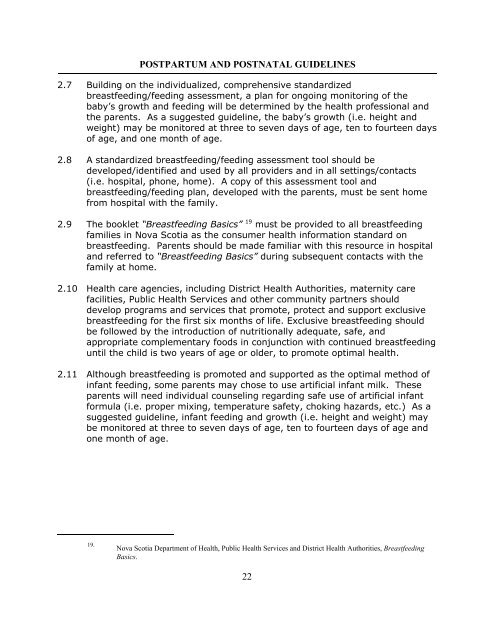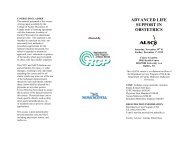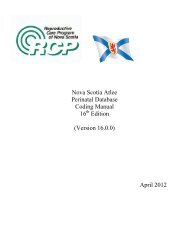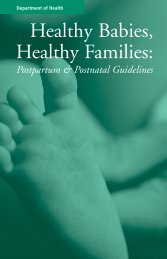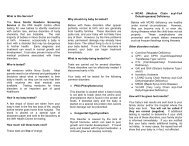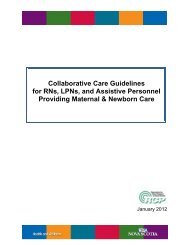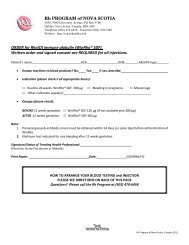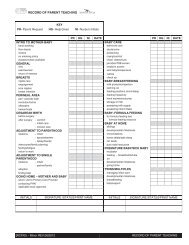Postpartum & Postnatal Guidelines - Reproductive Care Program of ...
Postpartum & Postnatal Guidelines - Reproductive Care Program of ...
Postpartum & Postnatal Guidelines - Reproductive Care Program of ...
Create successful ePaper yourself
Turn your PDF publications into a flip-book with our unique Google optimized e-Paper software.
POSTPARTUM AND POSTNATAL GUIDELINES<br />
2.7 Building on the individualized, comprehensive standardized<br />
breastfeeding/feeding assessment, a plan for ongoing monitoring <strong>of</strong> the<br />
baby’s growth and feeding will be determined by the health pr<strong>of</strong>essional and<br />
the parents. As a suggested guideline, the baby’s growth (i.e. height and<br />
weight) may be monitored at three to seven days <strong>of</strong> age, ten to fourteen days<br />
<strong>of</strong> age, and one month <strong>of</strong> age.<br />
2.8 A standardized breastfeeding/feeding assessment tool should be<br />
developed/identified and used by all providers and in all settings/contacts<br />
(i.e. hospital, phone, home). A copy <strong>of</strong> this assessment tool and<br />
breastfeeding/feeding plan, developed with the parents, must be sent home<br />
from hospital with the family.<br />
2.9 The booklet “Breastfeeding Basics” 19 must be provided to all breastfeeding<br />
families in Nova Scotia as the consumer health information standard on<br />
breastfeeding. Parents should be made familiar with this resource in hospital<br />
and referred to “Breastfeeding Basics” during subsequent contacts with the<br />
family at home.<br />
2.10 Health care agencies, including District Health Authorities, maternity care<br />
facilities, Public Health Services and other community partners should<br />
develop programs and services that promote, protect and support exclusive<br />
breastfeeding for the first six months <strong>of</strong> life. Exclusive breastfeeding should<br />
be followed by the introduction <strong>of</strong> nutritionally adequate, safe, and<br />
appropriate complementary foods in conjunction with continued breastfeeding<br />
until the child is two years <strong>of</strong> age or older, to promote optimal health.<br />
2.11 Although breastfeeding is promoted and supported as the optimal method <strong>of</strong><br />
infant feeding, some parents may chose to use artificial infant milk. These<br />
parents will need individual counseling regarding safe use <strong>of</strong> artificial infant<br />
formula (i.e. proper mixing, temperature safety, choking hazards, etc.) As a<br />
suggested guideline, infant feeding and growth (i.e. height and weight) may<br />
be monitored at three to seven days <strong>of</strong> age, ten to fourteen days <strong>of</strong> age and<br />
one month <strong>of</strong> age.<br />
19.<br />
Nova Scotia Department <strong>of</strong> Health, Public Health Services and District Health Authorities, Breastfeeding<br />
Basics.<br />
22


